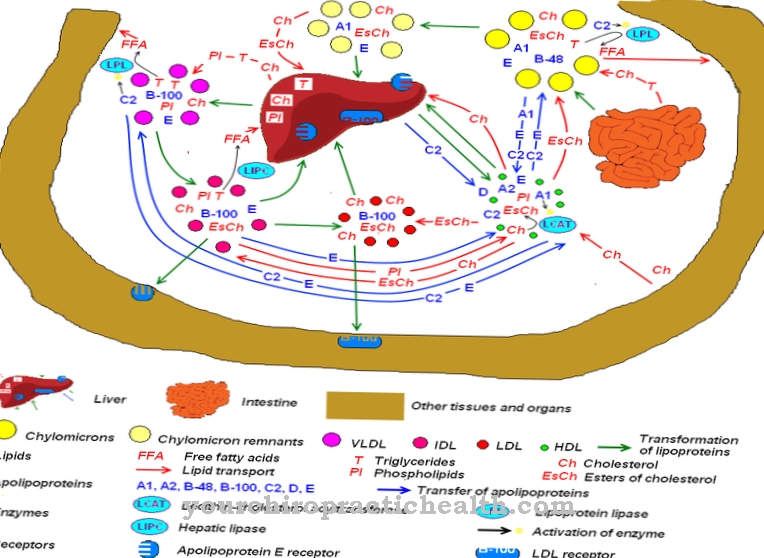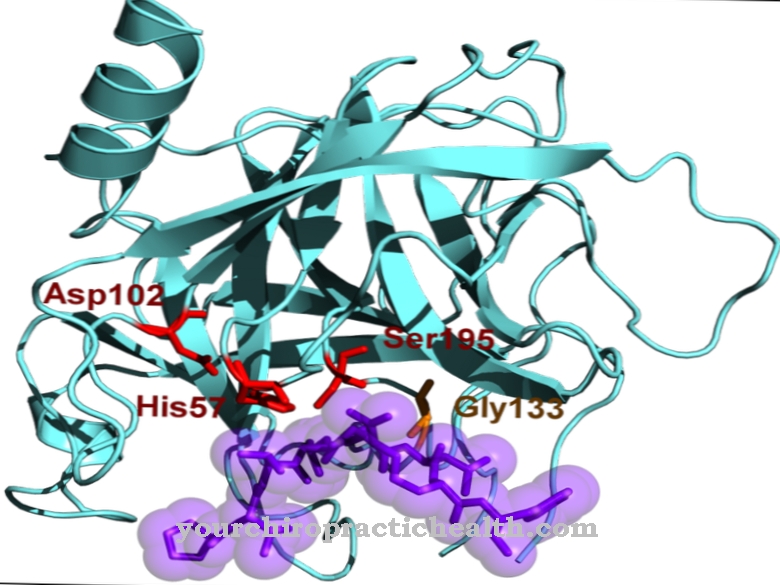Structural proteins serve primarily as tensile builders in cells and tissues. They usually have no enzymatic function, so they do not normally interfere with metabolic processes. Structural proteins usually form long fibers and give z. B. ligaments, tendons and bones their strength and motility, their mobility. Several different types of structural proteins make up about 30% of all proteins occurring in humans.
What is the structural protein?
Proteins, which mainly give the tissue its structure and tear resistance, are summarized under the term structural proteins. Structural proteins are characterized by the fact that they are usually not involved in enzymatic-catalytic metabolic processes.
Scleroproteins, which are counted among the structural proteins, usually form long chain molecules in the form of strung together amino acids, each of which is linked to one another via peptide bonds. Structural proteins often have recurring amino acid sequences, which allow the molecules special secondary and tertiary structures such as double or triple helices, which leads to particular mechanical strength. Important and known structural proteins are z. B. Keratin, Collagen and Elastin. Keratin is one of the fiber-forming structural proteins that give structure to the skin (epidermis) as well as hair and nails.
With over 24% of all proteins occurring in the human body, collagens form the largest group of structural proteins. What is striking about collagens is that every third amino acid is glycine and the sequence glycine-proline-hydroxyproline is accumulated. The tear-resistant collagens are the most important components of bones, teeth, ligaments and tendons (connective tissue). In contrast to collagens, which are barely stretchable, elastin gives certain tissues the ability to stretch. Elastin is therefore an important component in the lungs, in the walls of blood vessels and in the skin.
Function, effect & tasks
Various classes of proteins are subsumed under the term structural protein. All structural proteins have in common that their main function is to give structure and strength to the tissue in which they are found. A wide range of the necessary structural properties is required. Collagens, which form the structural protein in ligaments and tendons, are extremely tear-resistant, as the ligaments and tendons are exposed to high stresses in terms of tear resistance.
As a component in bones and teeth, the collagens must also be able to form break-proof structures. In addition to tear resistance, other body tissues need a special elasticity in order to be able to adapt to the respective conditions. Structural proteins, which belong to the group of elastins, fulfill this task. They can be stretched and are, to a limited extent, comparable to elastic fibers in fabric. Elastins enable rapid volume adjustments in blood vessels, lungs and various skins and membranes that envelop organs and have to cope with changing organ sizes. In human skin too, collagens and elastins complement each other to ensure both firmness and the ability to move the skin.
While collagens in ligaments and tendons mainly guarantee tensile strength in a certain direction, keratins, which are part of fingernails and toenails, have to ensure flat (two-dimensional) strength. Another class of structural proteins is made up of so-called motor proteins, which are the main component of muscle cells. Myosin and other motor proteins have the ability to contract due to a certain neuronal stimulus, so that the muscle temporarily shortens while using energy.
Education, Occurrence & Properties
Structural proteins, like other proteins, are synthesized in cells. The prerequisite is that the supply of the corresponding amino acids is guaranteed. First, several amino acids are linked to form peptides and polypeptides. These parts of a protein are put together on the rough endoplasmic reticulum to form larger parts and then to form a complete protein molecule.
Structural proteins that have to perform functions outside the cells in the extracellular matrix are labeled and are transported into the extracellular space by exocytosis by means of secretory vesicles. The required properties of the structural proteins cover a wide spectrum between tensile strength and elasticity. Structural proteins normally only occur as part of tissues, so that their concentration cannot easily be measured directly. An optimal concentration cannot therefore be given.
Diseases & Disorders
The complex tasks that the different structural proteins have to take on lead to the expectation that malfunctions can also occur that lead to disorders and symptoms. It can also lead to malfunctions within the synthesis chain because a large number of enzymes and vitamins are required for the synthesis.
The most noticeable disturbances arise when the corresponding proteins cannot be synthesized due to an undersupply of amino acids. The majority of the required amino acids can be synthesized by the body itself, but not the essential amino acids that have to be supplied from outside in the form of food or nutritional supplements. Even with an adequate supply of essential amino acids, the absorption in the small intestine can be disturbed due to illnesses or due to ingested toxins or as a side effect of certain drugs and cause a deficiency. A well-known, albeit rare, disease in this context is Duchenne muscular dystrophy.
The disease is caused by a genetic defect on the X chromosome, so only men are directly affected. The genetic defect means that the structural protein dystrophin, which is responsible for anchoring muscle fibers in the skeletal muscles, cannot be synthesized. This leads to a severe muscular dystrophy. Another - also rare - hereditary disease leads to mitochondriopathy. Several known genetic defects within DNA and mitochondrial DNA can cause mitochondria. A changed composition of certain mitochondrial structural proteins results in a reduced energy supply for the entire organism.













.jpg)

.jpg)
.jpg)











.jpg)